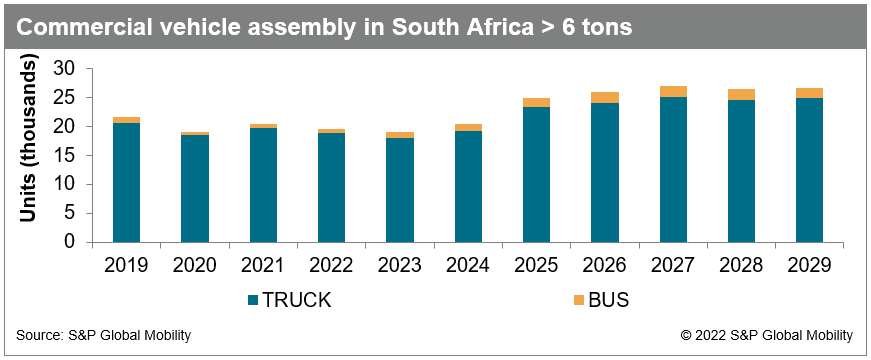Customer Logins
Obtain the data you need to make the most informed decisions by accessing our extensive portfolio of information, analytics, and expertise. Sign in to the product or service center of your choice.
Customer LoginsLoad-shedding disrupts recovery in South Africa truck and bus assembly
At a time when transportation is expected to shift to electric drivetrains and commercial vehicle OEMs scale back investment in combustion engines, these electric vehicles pose a huge challenge to South Africa, which has an unreliable power supply. The current power constraints lead to reduced output of medium and heavy commercial vehicles in 2022.
Since 2007, South Africa is suffering from a higher power demand than supply. Power cuts have been the result. Eskom, the state-owned firm which supplies more than 90% of South Africa's electricity, then came up with the term, load-shedding, for the power cuts. In the past years, load-shedding increased from 21 days in 2019 to a record 48 days in 2021. January to August 2022 already exceeded this number. The latest analysis on the topic forecasts power cuts to continue throughout the decade. More than 90% of South Africa's energy is produced by coal, about 6% by nuclear power and the build-up of alternatives is very slow.
The global developments in electric trucks and buses are also seen in South Africa and the country needs to be integrated into the global value chains for these vehicles. This was why the South African government drafted in 2021 a government Policy Discussion Paper, on the 'Advancement of New Energy Vehicles in South Africa', which dealt with this specific agenda.
South Africa's path to production of new electric vehicles needs to be considered within the context of the significant impact of on-going load-shedding. The constrained power grid on electricity generation and ensuing power interruptions are catastrophic especially for the industry. The automotive logistic value chain has already been affected, leading to partial production stoppages in truck and bus manufacturing. This could cause a major barrier to future investment in assembly facilities in South Africa.
Apart from global supply chain disruption and fuel price hikes, load-shedding has become the biggest challenge to the medium and heavy commercial vehicles in the country. It is now expected to disrupt and negatively impact the truck and bus assembly recovery. S&P Global Moblity (formerly IHS Markit | Automotive) has reduced its outlook for the truck and bus industry that is expected now to assemble less than 20,000 units in 2022, a decline of nearly 1,000 units compared to the prior year.
In addition to prolonged load-shedding which has contributed to
increased production costs, the industry is continuously faced with
semiconductor shortages; and global supply chain disruptions that
have resulted in insufficient completely-knocked-down kits for
truck and bus assemblers. The global chip shortage conundrum is
expected to continue in 2023, with the backlog carrying over into
2024. Despite increasingly tough economic circumstances, the
semiconductor supply chain shortage will revert to normality from
2025 onwards. The key drivers behind this path to a long-term
sustainable growth for the industry will come from continuous
growth in infrastructure development, increasing logistics
services, and ongoing replacement demand.
Throughout the forecast horizon to 2029, trucks and buses are
projected to be completely powered by fossil fuels. Unless concrete
policies for sustainable development are adopted, fossil fuels will
continue to dominate the market; even though leading OEMs have
commenced with their own strategic plans of importing electric
trucks and buses from their parent companies for local testing,
with commercialization mostly planned after 2025.
The South African government already has plans of progressively increasing the carbon tax rate and is expected to reach at least $30 per tonne by 2030. This demands that OEMs develop plans that gradually reduce their emissions; by investing in carbon-neutral assembly facilities and phase out the internal combustion engine. The switch to electric vehicles can only be successful if the power constraints are solved and the charging infrastructure is built up, since most long-distance land freight in South Africa is transported by road.
Menzi Nkonyane, Sr Research Analyst - Truck & Bus Research, Middle East/Africa
This article was published by S&P Global Mobility and not by S&P Global Ratings, which is a separately managed division of S&P Global.

